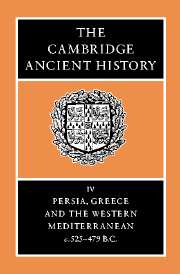Book contents
- Frontmatter
- Contents
- List of maps
- List of text-figures
- List of chronological tables
- Preface
- PART I THE PERSIAN EMPIRE
- PART II THE GREEK STATES
- PART III THE WEST
- BIBLIOGRAPHY
- Index
- Map 1. The Achaemenid empire
- Map 6. Central Asia
- Map 9. The Black Sea area
- Map 11. Egypt
- Map 13. Greek and Phoenician trade in the period of the Persian Wars
- Map 15. Greece and the Aegean
- Map 18. Northern and Central Italy
- Map 19. Central and Southern Italy
Preface
Published online by Cambridge University Press: 28 March 2008
- Frontmatter
- Contents
- List of maps
- List of text-figures
- List of chronological tables
- Preface
- PART I THE PERSIAN EMPIRE
- PART II THE GREEK STATES
- PART III THE WEST
- BIBLIOGRAPHY
- Index
- Map 1. The Achaemenid empire
- Map 6. Central Asia
- Map 9. The Black Sea area
- Map 11. Egypt
- Map 13. Greek and Phoenician trade in the period of the Persian Wars
- Map 15. Greece and the Aegean
- Map 18. Northern and Central Italy
- Map 19. Central and Southern Italy
Summary
In this volume we come to the transition from the archaic to the classical period in the Eastern Mediterranean. It is marked by the major events by which the Achaemenid empire of Persia came into conflict with the Greek city states, events which brought the concepts of Greek and Barbarian, freedom and despotism into the sharpest focus. But collision did not rule out influence, before and after the two years, 480 and 479, in which battle was most closely joined.
We begin by considering the geography and earlier history of the Iranian uplands where the Persian empire originated; it is now possible to do more than has previously been done in setting the archaeological against the literary picture; in the process it becomes clear how little we can say with confidence about the Median kingdom which Cyrus overthrew. But Cyrus' stature as a great leader can be more closely placed in its historical context and more justice than usual done to his son Cambyses.
That the empire survived for more than a generation was the work of Darius, who rescued it from disintegration and gave it solid institutions which carried it through the reverses sustained by his son Xerxes. The Persepolis excavations and the new texts which they produce are now making it possible to draw a picture of these institutions and their attendant culture which is at least partly independent of the Greek authors through whose eyes the empire has usually been seen.
- Type
- Chapter
- Information
- The Cambridge Ancient History , pp. xvii - xxiiPublisher: Cambridge University PressPrint publication year: 1988



